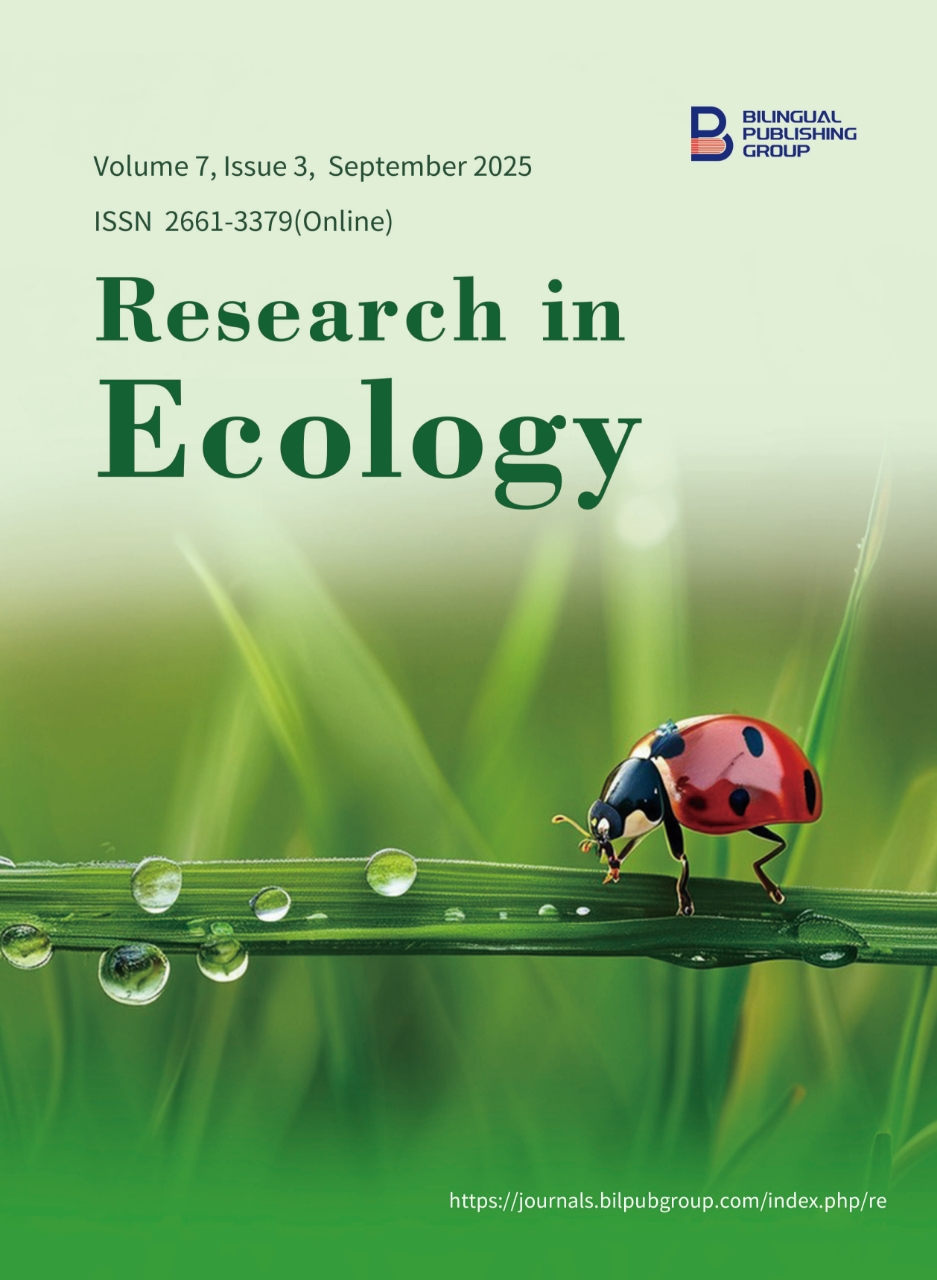
Biochar Enhances Soil–Plant–Microbe Interactions in Saline Soil
DOI:
https://doi.org/10.30564/re.v7i3.10503Abstract
A controlled pot experiment was carried out to examine the interactive effects of salinity stress and biochar on the growth, nutrient uptake, and soil microbial dynamics of Lablab purpureus. Results showed that wheat husk biochar significantly (p < 0.05) enhanced plant growth parameters compared to controls. Plant height increased by c. 53%, root length by 37%, fresh weight by 125%, and dry weight by 92% in wheat husk char treated soil under non-saline conditions. Wheat husk char also significantly increased pod number and node count per plant by c. 42% and 28% respectively. Nutrient analysis revealed higher concentrations of N (~6%), P (~0.3%), and K (~2%) in wheat husk biochar treatments, while salinity reduced nutrient uptake across all treatments. Although the number of flowers increased by c. 75%, the difference was not statistically significant. Although 16S rRNA gene copy numbers did not show significant changes in biochar treatments, enhanced microbial function indicated improved nutrient cycling and ecosystem functionality. Overall, the findings suggest that biochar can mitigate the adverse effects of salinity by improving plant physiological traits and stimulating microbial activity. This highlights biochar's potential as an ecological tool for sustainable agriculture, biodiversity enhancement, and ecosystem restoration in saline affected areas.
Keywords:
Salinity; Biochar; Nutrient Uptake; Microbial Dynamics; Plant; Enzyme; Ecosystem; BiodiversityReferences
[1] IPCC, 2023. Climate Change 2023: Synthesis Report. Contribution of Working Groups I, II and III to the Sixth Assessment Report of the Intergovernmental Panel on Climate Change. IPCC: Geneva, Switzerland. DOI: https://doi.org/10.59327/IPCC/AR6-9789291691647
[2] Atkinson, C.J., Fitzgerald, J.D., Hipps, N.A., 2010. Potential mechanisms for achieving agricultural benefits from biochar application to temperate soils: a review. Plant and Soil. 337(1), 1–18.
[3] Cao, X., Harris, W., 2010. Properties of dairy-manure-derived biochar pertinent to its potential use in remediation. Bioresource Technology. 101(14), 5222–5228.
[4] Ashraf, M., McNeilly, T., 2004. Salinity tolerance in Brassica oilseeds. Critical Reviews in Plant Sciences. 23(2), 157–174.
[5] Jackson, M.L., 2018. Soil chemical analysis, 2nd ed. Prentice Hall Inc: Englewood Cliffs, NJ, USA. pp. 1–498.
[6] Wu, H., Qi, Y., Dong, L., et al., 2019. Revealing the impact of pyrolysis temperature on dissolved organic matter released from the biochar prepared from Typha orientalis. Chemosphere. 228, 264–270.
[7] Joshi, G.A., Lester, B.J., Stewart, R.D., 2019. Talking SMAAC: a new tool to measure soil respiration and microbial activity. Frontiers in Earth Science. 7, 138.
[8] Yayi, N., Yulong, D., Yuqiang, L., et al., 2021. Soil microbial community responses to short-term nitrogen addition in China's Horqin Sandy Land. PLoS ONE. 16(5), e0242643.
[9] Xu, N., Tan, G., Wang, H., et al., 2016. Effect of biochar additions to soil on nitrogen leaching, microbial biomass and bacterial community structure. European Journal of Soil Biology. 74, 1–8.
[10] Field, A., 2017. Discovering Statistics Using IBM SPSS Statistics, 5th ed. SAGE Publications Ltd: London, UK. pp. 20–65.
[11] Evelin, H., Kapoor, R., Giri, B., 2009. Arbuscular mycorrhizal fungi in alleviation of salt stress: a review. Annals of Botany. 104(7), 1263–1281.
[12] Elsheikh, E.A.E., Wood, M., 2000. Nodulation and N2 fixation by soybean inoculated with salt-tolerant Rhizobia or salt-sensitive Bradyrhizobia in saline soil. Biochemistry of Soil Biology. 27(4–5), 657–661.
[13] Kaymakanova, M., Stoeva, N., 2008. Physiological reaction of bean plants (Phaseolus vulgaris L.) to salt stress. Plant Physiology. 34, 177–188.
[14] Filiberto, D.M., Gaunt, J.L., 2013. Practicality of biochar additions to enhance soil and crop productivity. Agriculture. 3(4), 715–725.
[15] Farissi, M., Bouizgaren, A., Faghire, M., et al., 2011. Agro-physiological responses of Moroccan alfalfa (Medicago sativa L.) populations to salt stress during germination and early seedling stages. Science and Technology. 39(2), 389–401.
[16] Dempster, N., Gleeson, B., Solaiman, M., et al., 2012. Decreased soil microbial biomass and nitrogen mineralization with eucalyptus biochar addition to a coarse textured soil. Plant and Soil. 354(1), 311–324.
[17] Kammann, C.I., Linsel, S., Gobling, J.W., et al., 2011. Influence of biochar on drought tolerance of Chenopodium quinoa wild and on soil–plant relations. Plant and Soil. 345(1), 195–210.
[18] Mohsen, A.A., Ebrahim, M.K.H., Ghoraba, W.F.S., 2014. Response of salt stressed Vicia faba plant to application of ascorbic acid on the growth and some metabolites. Iranian Journal of Plant Physiology. 4(2), 957–976.
[19] Raundal, P.U., Sabale, R.N., Kadian, V.S., 1999. Effect of phospho-manures on crop yield in mungbean-wheat cropping system. Journal of Maharashtra Agricultural University. 24(2), 151–154.
[20] Nesbitt, H.J., 2017. Rice production in Cambodia. International Rice Research Institute: Los Baños, Laguna, the Philippines. pp. 15–29.
[21] Bano, A., Fatima, M., 2009. Salt tolerance in Zea mays (L.) following inoculation with Rhizobium and Pseudomonas. Biology and Fertility of Soils. 45(4), 405–413.
[22] Zhang, T.A., Chen-Han, Y.H., Ruan, H.H., 2018. Global negative effects of nitrogen deposition on soil microbes. ISME Journal. 12(7), 1817–1825.
[23] Shabala, S., Demidchik, V., Shabala, L., et al., 2006. Extracellular Ca2+ ameliorates NaCl-induced K+ loss from Arabidopsis root and leaf cells by controlling plasma membrane K+ permeable channels. Plant Physiology. 141(4), 1653–1665.
[24] Lal, R., 2004. Carbon sequestration in dryland ecosystems. Environmental Management. 33(4), 528–544.
[25] Choppala, G.K., Bolan, N.S., Megharaj, M., et al., 2012. The influence of biochar and black carbon on reduction and bioavailability of chromate in soils. Journal of Environmental Quality. 41(4), 1175–1185.
[26] Faloye, O.T., Alatise, M.O., Ajayi, A.E., et al., 2019. Effects of biochar and inorganic fertiliser applications on growth, yield and water use efficiency of maize under deficit irrigation. Agricultural Water Management. 217, 165–178.
[27] Liu, W., Xu, W., Hong, J., et al., 2022. Interannual variability of soil microbial biomass and respiration in responses to topography, annual burning and N addition in a semiarid temperate steppe. Geoderma. 158(3–4), 259–267.
[28] Tan, H., Lee, C.T., Ong, P.Y., et al., 2021. A review on the comparison between slow pyrolysis and fast pyrolysis on the quality of lignocellulosic and lignin-based biochar. IOP Conference Series: Materials Science and Engineering. 1051(1), 012075.
[29] Al-Marzooqi, F., Yousef, L.F., 2017. Biological response of a sandy soil treated with biochar derived from a halophyte (Salicornia bigelovii). Applied Soil Ecology. 114, 9–15.
[30] Khan, T.F., Alam, M.D., 2018. Effects of biochar on legume-Rhizobium symbiosis in soil. Bangladesh Journal of Botany. 47(4), 945–952.
[31] Wei, C., Zheng, H., Li, Q., et al., 2012. Nitrogen addition regulates soil nematode community composition through ammonium suppression. PLoS ONE. 7(8), e43384. DOI: https://doi.org/10.1371/journal.pone.0043384
[32] Ahmad, R., Lim, C.J., Kwon, S.-Y., 2013. Glycine betaine: a versatile compound with great potential for gene pyramiding to improve crop plant performance against environmental stresses. Plant Biotechnology Reports. 7(1), 49–57.
[33] Hester, M.W., Mendelssohn, I.A., McKee, K.L., 2001. Species and population variation to salinity stress in Panicum hemitomon, Spartina patens, and Spartina alterniflora: Morphological and physiological constraints. Environmental and Experimental Botany. 46(3), 277–297.
[34] Zhou, M., Butterbach-Bahl, K., Vereecken, H., et al., 2017. A meta-analysis of soil salinization effects on nitrogen pools, cycles and fluxes in coastal ecosystems. Global Change Biology. 23(3), 1338–1352.
[35] Lehmann, J., Rillig, M.C., Thies, J., et al., 2011. Biochar effects on soil biota – a review. Soil Biology and Biochemistry. 43(9), 1812–1836.
[36] Warnock, D.D., Lehmann, J., Kuyper, T.W., et al., 2007. Mycorrhizal responses to biochar in soil – concepts and mechanisms. Plant and Soil. 300(1), 9–20.
[37] Biederman, L.A., Harpole, W.S., 2013. Biochar and its effects on plant productivity and nutrient cycling: a meta-analysis. GCB Bioenergy. 5(2), 202–214.
[38] Munns, R., Tester, M., 2008. Mechanisms of salinity tolerance. Annual Review of Plant Biology. 59(1), 651–681.
[39] Rengasamy, P., 2010. Soil processes affecting crop production in salt-affected soils. Functional Plant Biology. 37(7), 613–620.
[40] Kuzyakov, Y., Xu, X., 2013. Competition between roots and microorganisms for nitrogen: mechanisms and ecological relevance. New Phytologist. 198(3), 656–669.
[41] Luk, Y.L., Liang, X., Song, X., et al., 2023. Optimizing biochar particle size for plant growth and mitigation of soil salinization. Agronomy. 13(5), 1394.
[42] Gu, Y.Y., Liang, X.Y., Zhang, H.Y., et al., 2023. Effect of different biochar particle sizes and bio-organic fertilizer on rhizosphere microecological environment in saline–alkali land. Frontiers in Microbiology. 14, 1190716. DOI: https://doi.org/10.3389/fmicb.2023.1190716
Downloads
How to Cite
Issue
Article Type
License
Copyright © 2025 Tazeen Fatima Khan, Md Golam Sarwar Anik, Sonia Hossain

This is an open access article under the Creative Commons Attribution-NonCommercial 4.0 International (CC BY-NC 4.0) License.




 Tazeen Fatima Khan
Tazeen Fatima Khan






